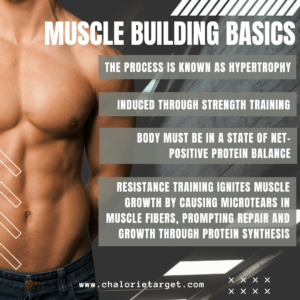For fitness enthusiasts and weightlifters, the dichotomy of muscle building and weight loss has long been a central enigma. Traditionally, it’s been suggested that building muscles requires a calorie surplus. The where energy intake exceeds the body’s expenditure, tipping the scales in the muscle’s favor for growth.
Conversely, weight loss necessitates a calorie deficit, where energy expenditure outstrips intake, enabling fat loss. But the question remains: is it possible to build muscle in a calorie deficit? For anyone striving to sculpt their physique, this question is more than just a fitness curiosity.
It’s the holy grail of body recomposition. The simultaneous shedding of fat while building muscle and it could revolutionize how we approach our fitness goals.
1. Understanding Calorie Deficits
A calorie deficit is fundamental to the law of energy balance. It is based on the notion that you must consume fewer calories to lose weight than your body burns. But what does that mean for gaining muscles mass? The relationship is complex.
When in a calorie deficit, the body often turns to muscle as an energy source. This could potentially jeopardize the gains from strenuous workouts. However, the picture could be more stark; advancements in fitness and nutritional science reveal there are nuances to muscle upkeep within a depleted diet.
Understanding the nuances of a calorie deficit is paramount in pursuing optimal health and body composition. Not only calories but the quality of nutrients and body’s responsiveness to specific dietary interventions. A strategic approach to a calorie deficit can balance fat loss and muscle upkeep for muscle preservation or growth.
Creating a diet to gain muscles with fewer calories is like mastering a delicate balance. It involves knowing the right mix of nutrients like carbs, proteins, and fats, and timing when you eat them with your workouts. Additionally, recognizing the role of genetics and individual metabolic responses to diet and exercise can refine our approach to achieving the physiques we desire.
Read More: The Surprising Truth About the Most Calorie-Dense Macronutrient
2. Muscle Building Basics
Before we start discus building muscle when you’re eating less, it’s important to get the basics of how muscles grow. Understanding the principles of muscle growth is key to designing an effective workout plan. The process is known as hypertrophy, facilitated by metabolic stress and muscle damage. This is typically induced through strength training.

Protein synthesis is the driving force behind muscle repair and growth after a workout. For muscle hypertrophy to occur, the body must be in a state of net-positive protein balance. The rate of muscle protein synthesis exceeds the rate of muscle protein breakdown. The role of protein intake in this process is central in muscle maintenance and repair.
Resistance training is the spark plug for muscle building. It creates microtears in muscle fibers, initiating the repair and growth process facilitated by protein synthesis. When the body is subjected to more excellent resistance over time, it increases muscle mass in size and strength.
Read More: What are Net Calories: The Key to Effective Weight Management
3. Is it Possible to Build Muscle in a Calorie Deficit?
Conventional wisdom suggests muscle building is incompatible with calorie deficits, yet anecdotal evidence and emerging research hint at a more nuanced scenario. This section will address the preconceived myths and the scientific data that challenge them.
The most common misconception is that a calorie deficit leads to muscle loss. While this can occur, the rate and extent of muscle catabolism vary depending on numerous factors. These include depth of the deficit, nutrient partitioning, exercise selection, and hormonal milieu.
Research shows that even when you’re eating less, your muscles can still maintain or even grow thanks to protein synthesis. This means that it’s possible to keep or build muscle in specific situations where you’re not getting enough calories.
Hormonal adaptations, like higher levels of catecholamines and growth hormone, might protect your muscles when you’re not eating enough. They do this by promoting fat loss instead of muscle breakdown.
The key to success lies in fine-tuning one’s approach to diet and training. Finding the sweet spot where the calorie deficit is sufficient to promote fat loss. But not so steep that it compromises muscle mass.
4. Strategies for Building Muscle in a Calorie Deficit
Knowing that eating fewer calories doesn’t have to stop muscle growth. Let’s look at practical ways to keep building muscle even when you’re cutting back on food.
a. Nutrition Strategies
The strategic manipulation of macronutrients is potent for steering the body toward muscle gain. In a calorie deficit, preserving muscle requires a high-protein diet rich in amino acids. Typically, protein intake is recommended at 1.6-2.2 grams of protein per kilogram of body weight, though personalized adjustments based on activity levels and metabolic rate may be necessary.
Carbohydrates also play a critical role, serving as the body’s primary energy source for high-intensity workouts. Consuming a moderate amount of carbohydrates can provide the fuel to engage in practical resistance training. This will keeping blood sugar levels stable to avoid muscle catabolism.
Fats are essential for hormone production, particularly testosterone, critical for muscle growth. Including a mix of saturated, monounsaturated, and polyunsaturated fats can support overall health and anabolic processes.
b. Training and Workout Programs
Designing a workout program or training program to preserve muscle in a calorie deficit is an art. Prioritize resistance training to provide the stimulus for muscle maintenance and growth. Multi-joint compound exercises engage multiple muscle groups, promoting the release of muscle-preserving hormones like growth and testosterone.
While cardiovascular exercise is essential for overall health and calorie burning, excessive cardio in a calorie deficit can accelerate muscle loss. Opt for shorter and higher-intensity cardio sessions. One may also try methods like HIIT (High-Intensity Interval Training) that are less muscle catabolic.
c. Rest and Recovery
Rest and recovery are just as vital as the workout in the pursuit of body recomposition. Adequate sleep is crucial for hormone regulation and muscle repair. The consensus is around 7-9 hours of quality sleep per night for most individuals.
Active recovery, such as low-intensity cardio or mobility work, can alleviate muscle soreness and support recovery. Avoid overtraining, which can elevate cortisol levels and promote muscle breakdown.
Read More: How Much Protein is in a Pound of Steak?
4. Can You Be In A Caloric Deficit And Gain Muscle?
The answer is yes, but it needs effort and work. Building muscle in a calorie deficit requires precision and consistency in nutrition and training. Monitoring progress through measurements, such as body composition changes, is crucial rather than solely relying on the scale.
Understanding the metabolic response to diet and exercise can refine our approach to achieving the physiques we desire. With careful planning and execution, building muscle in a calorie deficit is no longer an impossibility. This will be a challenge for those willing to do the work.
Further research and experimentation may reveal even more effective strategies for building muscle in a calorie deficit.
Progress takes time and effort, but you can achieve your muscle-building goals with the right approach, even in a calorie deficit. Stay consistent and adjust strategy.
5. What’s Most Important for Building and Keeping Muscle Mass?
Many factors contribute to building and maintaining muscle mass, but some stand out as particularly crucial. These include proper nutrition, consistent training, adequate rest and recovery, and a positive mindset.
Nutrition is the foundation of muscle building. With sufficient protein and energy intake, our body will have the resources to repair and grow muscles. Similarly, training consistently is essential for providing the stimulus needed to build muscle. Rest and recovery are also crucial as they allow our bodies to do so.
a. Consistency
Consistency is vital for building and maintaining muscle mass. This means consistency in both nutrition and training. Regularly sticking to a balanced exercise routine helps you steadily increase the challenge, which is crucial for building muscle. Likewise, sticking to a steady diet ensures muscle growth.
b. Mindset
In addition to the physical aspects, having a positive mindset is crucial for building and maintaining muscle mass. Trust in yourself and the journey; results come with time, effort, and consistency. So stay focused on your goals and remember to be patient and persistent in building muscle.
Read More: Why are Carbohydrates and Fats Considered High Energy Foods
6. Conclusion
Building muscle in a calorie deficit is possible but requires a strategic approach and consistency. Proper nutrition, training, rest and recovery, and a positive mindset are all critical components for achieving this goal.
By understanding the science behind body recomposition and using it to our advantage. With this we can defy traditional beliefs and achieve our desired physiques. So keep pushing yourself, stay dedicated, and trust in the process. Remember, the journey towards a more robust, leaner, and muscular body is challenging yet rewarding.
